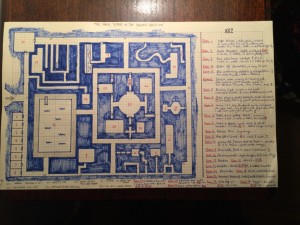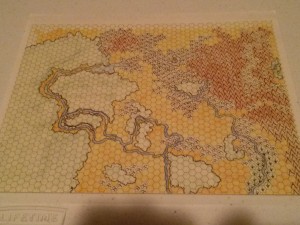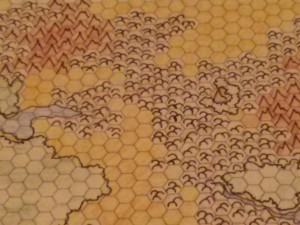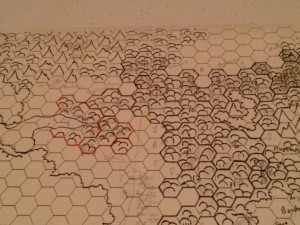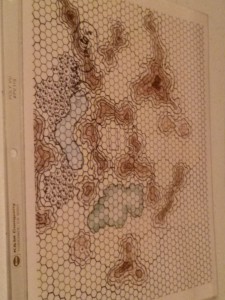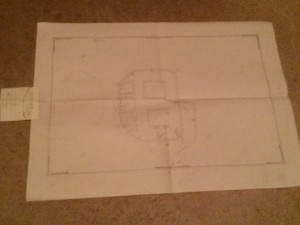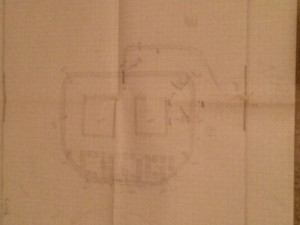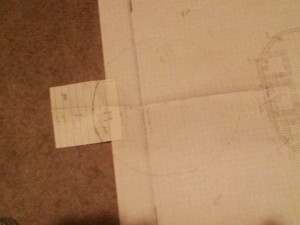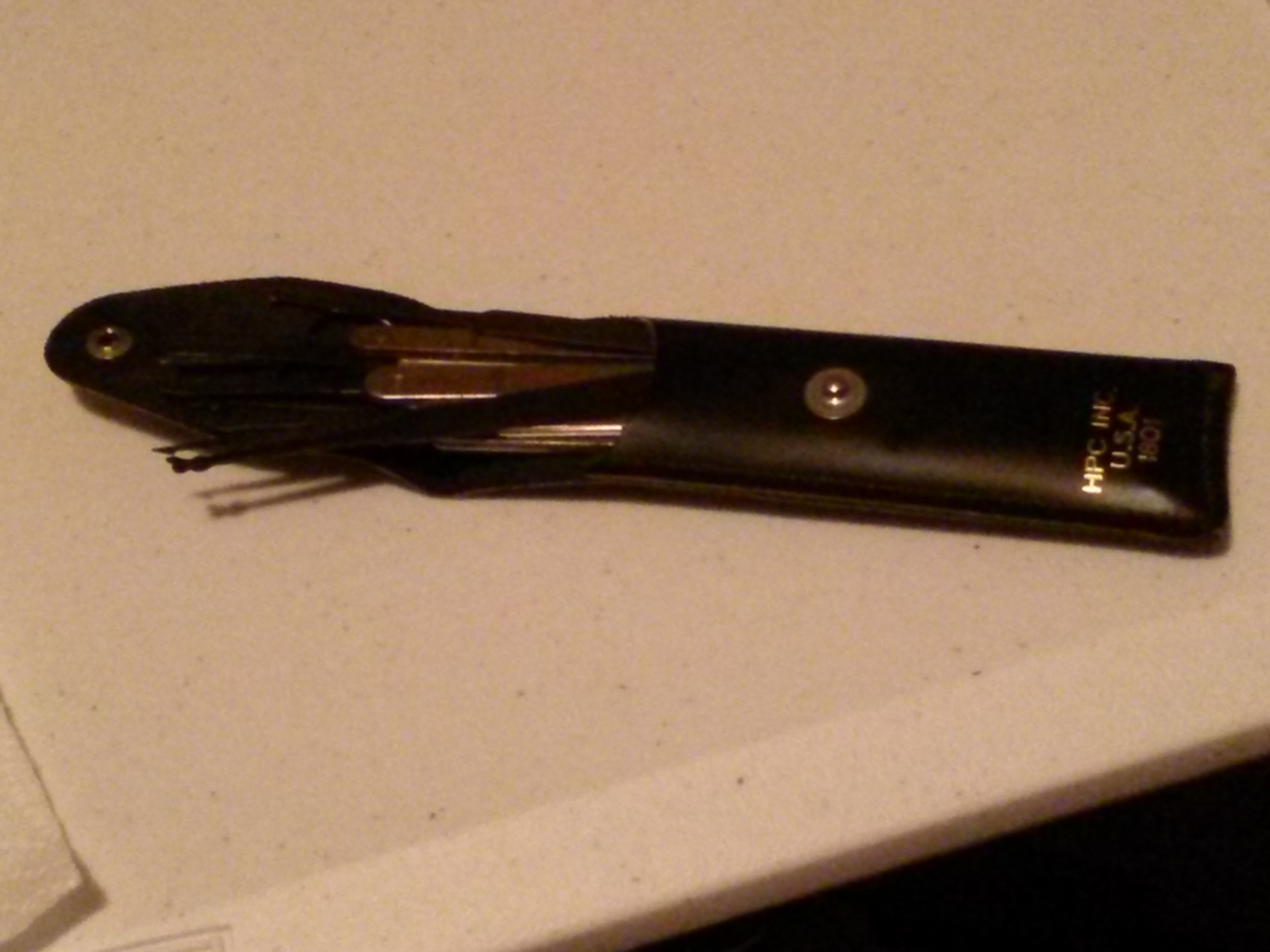Back in the mid to late 80’s I bought a quad ruled desk pad from an office supply store. That was back when desk pads and pen and paper were still the mainstay of business. I have only one sheet from that desk pad that holds the map to the town for Griswald, the longest running character I have played, who is now, essentially retired from play.
I don’t know what happened to the rest of the pad. I used it for mapping out a Boot Hill area, and such things. I think that pad may have been one of the things I lost in the water leak incident, but I don’t recall.
I have in the last few years tried to find such a pad in stock at an office supply store, but no go. I would have to special order or order online. If you search for quad ruled desk pad you will find them. They run a little under $20 each.
I like using them to map out large cities. I am a visual person and like to be able to see them. In my campaign, there are ten ancient cities of a fallen empire. I have taped together 8.5 x 11 quad ruled graph paper for a rough map of the one closest to the action of the current group of players. Having a bigger single sheet would simplify things and make it easier to fold up and get out of the way.
I also like he idea of using them for a megadungeon. Who doesn’t want to design a megadungeon? I think I started to do so way back in the day, but it is lost material.
This all comes to mind as I ran across Peter Regan’s most recent Kickstarter for a Dungeon Desk Pad, over at Oublette Magazine. It is an interesting idea. I am trying to avoid new Kickstarters for the financial responsibility end of it, but man is this one hard to resist. Personally, I prefer a full-size desk pad of grids, but this idea is interesting. My desk pad pages are 16 inches by 22 inches, slightly smaller than the A2 standard. The Dungeon Desk Pads are 16.53 inches by 11.69 inches, which is the A3 standard. The other issue is that Peter is UK based so overseas shipping adds to costs, etc. So far, I have only backed US-based Kickstarters, mainly because I have not had interest in others that were not based in the US. I know that Peter has a good track record, thus hitting the funding goal, and stretch goals are reasonable and fit with the base project.
I was also intrigued by an article that Peter shared that of Ian Livingstone of Games Workshop [former link: http://unpluggedgames.co.uk/2015/02/13/games-workshop-the-inside-story-part-one/] still has his first dungeon on a desk pad on his desk. You can save this photo and zoom in to be able to read the room descriptions. It would be easy to use this for a quick dungeon for your next session.
This motivated me to get the rough map of Helmsdale, Griswald’s town, and share it here. The quick story on this town. My brother, Robert,the DM determined that for Griswald to be a half-elf, it made sense for the human to come from a place near the Elven Kingdom. The hillsmen in his campaign are based on the Scottish clans. They live in a series of hills called Carbaen Moor. Griswald is a Fighter/Cleric/Magic-User and we rolled his age. I believe 45 years old, so the backstory is that the hillsmen had a civil war where the Buchanan Clan Kicked the Stewarts out of their territory and became king. They did not maintain control of the Stewart territory so it became infested with Orcs and worse.
Griswald’s father was a duke, and as far as Griswald knew, he was the true heir to the throne. He later learned that the grandson of the king and the grandsons of the dukes higher in precedence had their own band of outlaws called the Red Arrows. They had red fletchings (feathers) on their arrows. Griswald joined up with them, and through creative use of magic and bluff developed a reputation beyond their actual abilities. Tameus, the true king, decided it was time for war. Through lots of favors owed and other factors and army big enough to challenge the Buchanan’s was raised, and while outnumbered by the Buchanans, magic and Elven cavalry defeated them. After reclaiming the kingdom, there was a massive earthquake that devastated most of the kingdom and the old Stewart lands. Since the orc tribes in the Stewart lands bordering the former Buchanan lands were hurt as bad as the humans, Griswald decided to take back his ancestral lands. With the help of a small force of mercenaries and a PC wizard and his own henchmen – two fighters and three magic users, the orcs where driven out.
The town is in a valley of a ring of hills. It has a ditch 30 feet wide and 20 feet deep. The earthquake reduced the walls. Griswald rebuilt a smaller town with an Elven temple, the price of the Elven troops. This works for Griswald as he is a cleric of the Elven moon diety, Isil-nar. There is also the ducal palace and homes for troops and workers and farmers. Outside the walls is an inn, The Merchant’s Delight. The merchants like Griswald, since he does not tax them as heavily as the orcs. He also built a gatehouse at the only way across the ditch.
The two biggest orc tribes were not hurt by the earthquake, and were consolidating their control over the remnants of the orc tribes Griswald had not yet eliminated. These tribes did not like this upstart half elf moving in, so they moved to invade and take him out. Griswald has a crystal ball so he looked for the leaders of the invaders and took Alim, his highest level magic user henchman to teleport to these troops on the march to take them out. While the two most powerful magic users in town, Griswald 10th fighter/10th cleric/11th magic user and Alim, 10th level magic user were gone, the other orc tribe got past the wall across the valley to the south and surrounded the town. Griswald and Alim mangled the rear guard of the larger force and were gone until morning. This was put on hold for 15 years, until we made it work to finish the scenario. Robert wanted to resolve it so the other players would know what happened, as they are ten or more game years past this point in time.
The orcs surrounding the town set up a catapult and started battering the walls. They also attacked the gatehouse with 50 men that were the troops of Logan, a PC who was killed, but the men stayed with Griswald. The gatehouse was cut off from the rest of town and the 30 or so cavalry on hand tried to get through, but were routed and nearly all of them were killed. The archers on the walls of town made long range shots at the orcs around the gatehouse, and nearly exhausted all the available arrows. The gatehouse fell. The high priest of the temple cast insect plague in the area around the catapult to delay the battering. By the next morning the high priest rested and relearned insect plague and cast it again. Somewhere in here, we had a two year delay of getting together to wrap it up, but we finally finished it.
Finally when the time line in town caught up to them, Griswald and Alim read teleport from their travelling spell books and returned to the palace. Griswald and Alim had hardly any spells or scrolls left, but as a fighter with protection from normal missiles, Griswald could mount the walls and fight off the invaders. Finally enough orcs were killed that their morale broke. I don’t know if I ever got a full count of the number of dead orcs, but the image in my mind is of The Battle of Roake’s Drift from the movie Zulu. Thankfully, it was not The Battle of Islandawana.
On this map each square = 40 feet. I found that the width of the squares is the same as the distance between the lines on a standard 3 x 5 index card. Index cards were handy for measuring ranges in the battle. We used a few miniatures, but was mostly scribbles on the map.
Every time an orc was killed we yelled, “Oh no! They got Grignak!” The inspiration for Grignak comes from Galaxy Quest.
First the map of the “north” of my brother’s campaign. This is one half of a TSR hex mapping paper, with the Willingham cover. The other half is the “south”. Only one player has been off this map. It is 10 mile hexes. This is a photocopy. I did the coloring. Robert used the photocopier to enlarge and zoom in in the following images. These are pictures and not scans. You still get a hint of my brother’s artistic talent here.
The Stewart Lands shows the fiefs of the various Stewart Dukes.
Below shows the ring of hills with an opening in the hills to the North West and South. The rectangle in the center is where the town goes.
The post it note was added to complete the circle for the area of effect of insect plague. That spell is one of the ultimate battlefield spells if you can buy a high priest ten minutes (one turn) to cast it.
This is in pencil on 20+ year old paper with poor lighting.
I am curious if there are any other desk pad sized maps of towns, dungeons, space ships, etc. That would be an interesting gallery.

